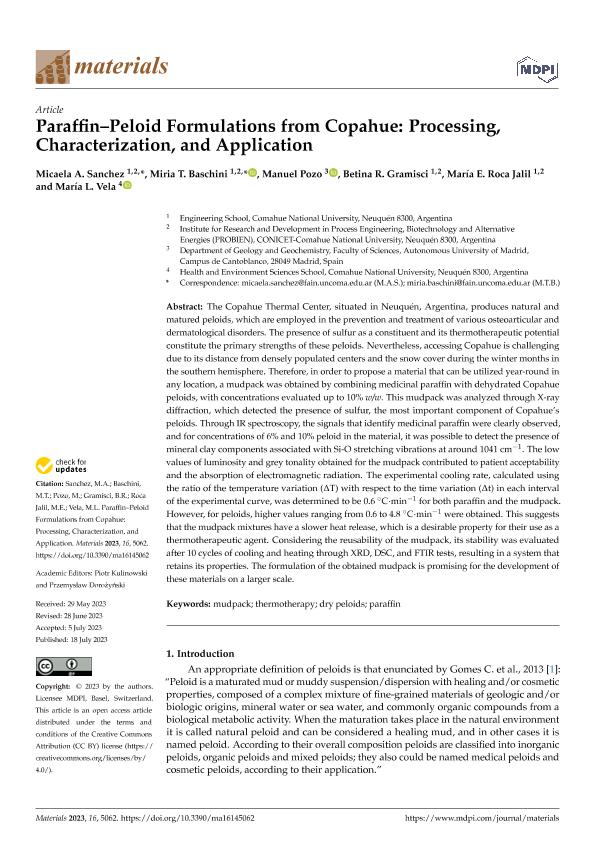Mostrar el registro sencillo del ítem
dc.contributor.author
Sanchez, Micaela Andrea

dc.contributor.author
Baschini, Miria Teresita

dc.contributor.author
Pozo, Manuel
dc.contributor.author
Gramisci, Betina Rocío

dc.contributor.author
Roca Jalil, María Eugenia

dc.contributor.author
Vela, María L.
dc.date.available
2024-02-19T14:06:47Z
dc.date.issued
2023-07
dc.identifier.citation
Sanchez, Micaela Andrea; Baschini, Miria Teresita; Pozo, Manuel; Gramisci, Betina Rocío; Roca Jalil, María Eugenia; et al.; Paraffin–Peloid Formulations from Copahue: Processing, Characterization, and Application; MDPI; Materials; 16; 14; 7-2023; 1-14
dc.identifier.issn
1996-1944
dc.identifier.uri
http://hdl.handle.net/11336/227411
dc.description.abstract
The Copahue Thermal Center, situated in Neuquén, Argentina, produces natural and matured peloids, which are employed in the prevention and treatment of various osteoarticular and dermatological disorders. The presence of sulfur as a constituent and its thermotherapeutic potential constitute the primary strengths of these peloids. Nevertheless, accessing Copahue is challenging due to its distance from densely populated centers and the snow cover during the winter months in the southern hemisphere. Therefore, in order to propose a material that can be utilized year-round in any location, a mudpack was obtained by combining medicinal paraffin with dehydrated Copahue peloids, with concentrations evaluated up to 10% w/w. This mudpack was analyzed through X-ray diffraction, which detected the presence of sulfur, the most important component of Copahue’s peloids. Through IR spectroscopy, the signals that identify medicinal paraffin were clearly observed, and for concentrations of 6% and 10% peloid in the material, it was possible to detect the presence of mineral clay components associated with Si-O stretching vibrations at around 1041 cm−1. The low values of luminosity and grey tonality obtained for the mudpack contributed to patient acceptability and the absorption of electromagnetic radiation. The experimental cooling rate, calculated using the ratio of the temperature variation (∆T) with respect to the time variation (∆t) in each interval of the experimental curve, was determined to be 0.6 °C·min−1 for both paraffin and the mudpack. However, for peloids, higher values ranging from 0.6 to 4.8 °C·min−1 were obtained. This suggests that the mudpack mixtures have a slower heat release, which is a desirable property for their use as a thermotherapeutic agent. Considering the reusability of the mudpack, its stability was evaluated after 10 cycles of cooling and heating through XRD, DSC, and FTIR tests, resulting in a system that retains its properties. The formulation of the obtained mudpack is promising for the development of these materials on a larger scale.
dc.format
application/pdf
dc.language.iso
eng
dc.publisher
MDPI
dc.rights
info:eu-repo/semantics/openAccess
dc.rights.uri
https://creativecommons.org/licenses/by/2.5/ar/
dc.subject
DRY PELOIDS
dc.subject
MUDPACK
dc.subject
PARAFFIN
dc.subject
THERMOTHERAPY
dc.subject.classification
Otras Ciencias de la Tierra y relacionadas con el Medio Ambiente

dc.subject.classification
Ciencias de la Tierra y relacionadas con el Medio Ambiente

dc.subject.classification
CIENCIAS NATURALES Y EXACTAS

dc.title
Paraffin–Peloid Formulations from Copahue: Processing, Characterization, and Application
dc.type
info:eu-repo/semantics/article
dc.type
info:ar-repo/semantics/artículo
dc.type
info:eu-repo/semantics/publishedVersion
dc.date.updated
2024-02-19T10:34:37Z
dc.journal.volume
16
dc.journal.number
14
dc.journal.pagination
1-14
dc.journal.pais
Dinamarca

dc.description.fil
Fil: Sanchez, Micaela Andrea. Consejo Nacional de Investigaciones Científicas y Técnicas. Centro Científico Tecnológico Conicet - Patagonia Norte. Instituto de Investigación y Desarrollo en Ingeniería de Procesos, Biotecnología y Energías Alternativas. Universidad Nacional del Comahue. Instituto de Investigación y Desarrollo en Ingeniería de Procesos, Biotecnología y Energías Alternativas; Argentina
dc.description.fil
Fil: Baschini, Miria Teresita. Consejo Nacional de Investigaciones Científicas y Técnicas. Centro Científico Tecnológico Conicet - Patagonia Norte. Instituto de Investigación y Desarrollo en Ingeniería de Procesos, Biotecnología y Energías Alternativas. Universidad Nacional del Comahue. Instituto de Investigación y Desarrollo en Ingeniería de Procesos, Biotecnología y Energías Alternativas; Argentina
dc.description.fil
Fil: Pozo, Manuel. Universidad Autónoma de Madrid; España
dc.description.fil
Fil: Gramisci, Betina Rocío. Consejo Nacional de Investigaciones Científicas y Técnicas. Centro Científico Tecnológico Conicet - Patagonia Norte. Instituto de Investigación y Desarrollo en Ingeniería de Procesos, Biotecnología y Energías Alternativas. Universidad Nacional del Comahue. Instituto de Investigación y Desarrollo en Ingeniería de Procesos, Biotecnología y Energías Alternativas; Argentina
dc.description.fil
Fil: Roca Jalil, María Eugenia. Consejo Nacional de Investigaciones Científicas y Técnicas. Centro Científico Tecnológico Conicet - Patagonia Norte. Instituto de Investigación y Desarrollo en Ingeniería de Procesos, Biotecnología y Energías Alternativas. Universidad Nacional del Comahue. Instituto de Investigación y Desarrollo en Ingeniería de Procesos, Biotecnología y Energías Alternativas; Argentina
dc.description.fil
Fil: Vela, María L.. Universidad Nacional del Comahue; Argentina
dc.journal.title
Materials
dc.relation.alternativeid
info:eu-repo/semantics/altIdentifier/url/https://www.mdpi.com/1996-1944/16/14/5062
dc.relation.alternativeid
info:eu-repo/semantics/altIdentifier/doi/http://dx.doi.org/10.3390/ma16145062
Archivos asociados
